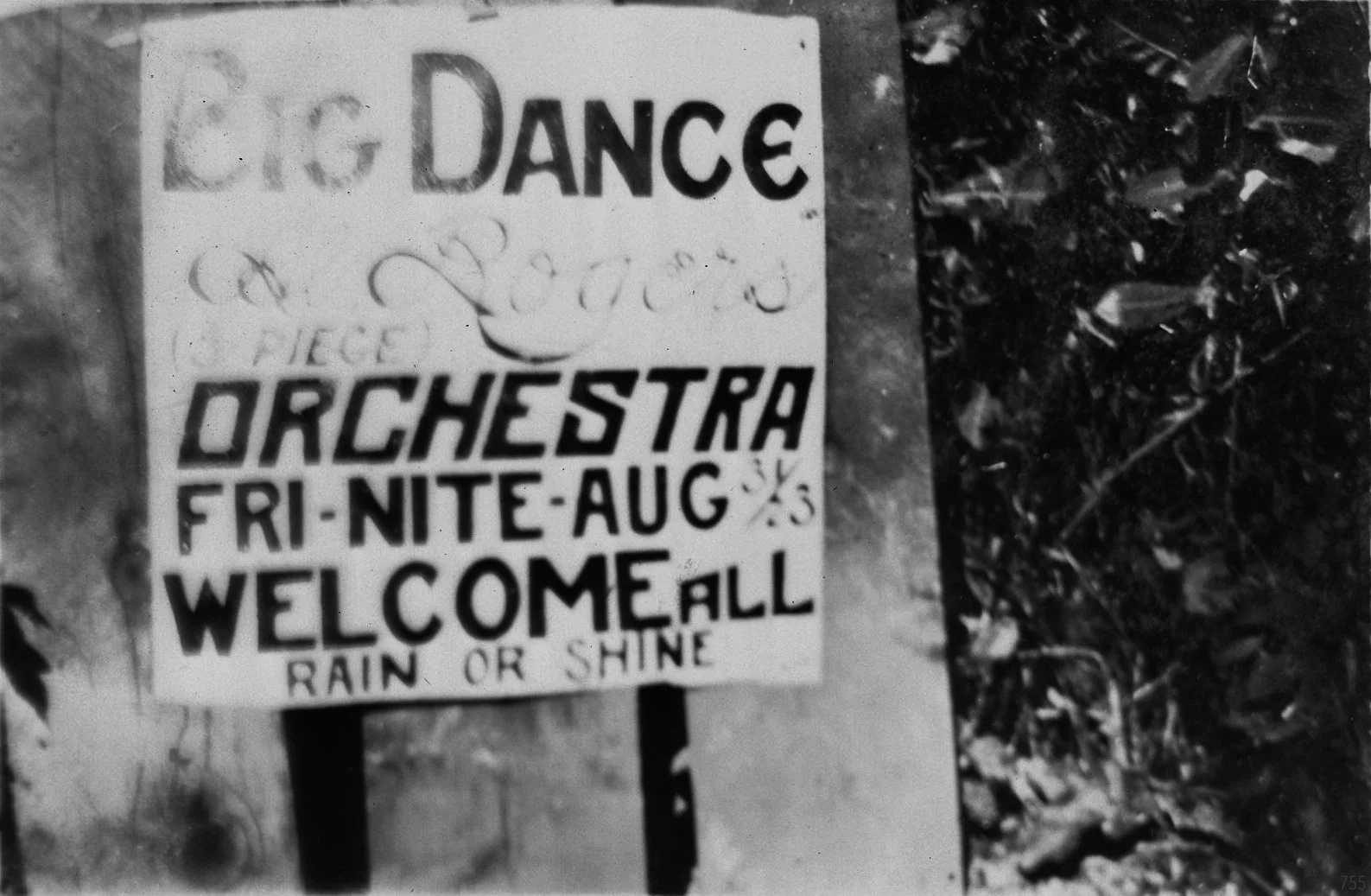Learning to Dance
An advertisement for an upcoming dance with a 3-piece orchestra band, August 31th 1923. (Courtesy: Kanien'kehá:ka Onkwawén:na Raotitióhkwa Language and Cultural Center)
Story told by Mary Claus
All those dances at the Council House, they were always a big deal when we were kids - teenagers. I remember the first dance I went to with a date. We were both kids and we’d been friends forever. Neither one of us knew how to dance. So, mum, being a teacher, decided that she would teach us how to dance in the living room.
We put a record on and she taught us the one step back, the two steps forward - the basics of the waltz. It goes one step back, two steps forward, one step back, and so on. And then of course mum would be turning, turning and pirouetting around the living room. My date and I, we learned this from mother. So, we went to the dance together. The Council House was always a wonderful experience because all these people were there and the band was up on the platform.
It was all people from the community and all ages too. There were little kids skidding across the floor, you know, that sort of thing. They used to put this stuff on the floor that made it slidey. Kind of a granule thing. They’d sprinkle it so that when you turn, you know, it was easy, smooth, gliding across the floor.
So, my date and I are on the west side of the Council House, sitting timidly in the corner. Then all of a sudden, we decided, this is the time we dance.
Well off we went. One step back, two steps forward. We went on a straight diagonal, right across the hall, through all the people swirling and turning. There’s him and I, one step back, two steps forward. Straight across - we got to the other side, turned around, then came back the same way. That was my introduction to the waltz. The Council House was always a riot.
At the dances, we had a clanky, old, upright piano. My brother would know who all played because, you know, he’s older. Then we had a guy on the drums with those squishy kind of whisky things - whisks, whisks, whisks - a lovely sound. Up on the stage, there was that and a guy who played the violin - the fiddle. It was a fiddle.
And then we had someone who would call the square dances. They were fun too. Learning to square dance was fun. I remember my friend and I were doing the square dance. Neither of us really knew how to do that either. But the older people in the circle could guide you and push you through where you're supposed to be. Anyway, we took this deadly turn and I had my arm up. I was supposed to be turning under somebody’s arm and, instead, I got my friend right on the side of his head with my elbow. Oh those swift turns! Yeah. He’s dead and gone now, but we had good times.
KANIEN’KÉHA VERSION
↓
KANIEN’KÉHA VERSION ↓
Aieweientéhta'ne Taienónniahkwe
A dance admission ticket with floor show at the Kirby Dance Hall (Courtesy: Kahsennenhawi Kirby)
Mary Claus IAKOKÁ:RATON
Akwé:kon thí:ken kanonnia'shòn:'a ne Council House nonkwá:ti, tió:konte' tkontikowá:nenskwe' shiiakwaksà:'a - ken' shitionkwaién:sa. Kè:iahre' shontontié:renhte' wa'tiakeninonniahkwà:na' skátne iatiaterihwísa'as. Tetsá:ron' wáhi ken' shitionkeniién:ha tánon tiokontáhkwen' kwah tokèn:'en shiiontiatén:ro. Kwah iah teiakeninonniaweienhòn:ne. Thò:ne ki', Istá, iakorihonnienníhahkwe', wa'onte'nikonhrísa' enionkhirihónnien tsi ní:ioht tsi taiakeninónniahkwe ne tsi kanonhsí:io nonkwá:ti.
Wa'akwarennà:ren' tánon wa'onkhirihónnien' thí:ken tso'kháha ohnà:ken ionhtentià:tha, teio'kháhake ohén:ton ionhtentià:tha – ne ki' nen' nè:'e ne karihwakwe'ní:ios ne waltz nikanonniò:ten. Kwah tso'kháha ohnà:ken enionhténtia'te, teio'kháhake ohén:ton entsonhténtia'te, tso'kháha ohnà:ken entsonhténtia'te, kwah tho nentsóhton. Sok ki' tsi niioren'nhà:'on Istá enionttsinonhwatenia'tánion ne tsi kanonhsí:io nonkwá:ti. Iatiaterihwísa'as tánon nì:'i, Istá wa'onkhirihónnien' kí:ken. Thò:ne ki', skátne wa'tiakeninonniahkwà:na'. Tió:konte ion'wesèn:ne' ne Council House nonkwá:ti áse' kenh tó:k nitionkwehnè:ne tánon eh tkanenhráhere tsi kaswen'karáhere ratirén:note ne ronterennótha.
Akwé:kon kanatakonhró:non tánon akwé:kon tsi nithotí:iens ó:ni eh rón:nes. Kwah tsi nikaswèn:kares tehonto'tsinehtánions ne ken' nihonná:sa, saterièn:tare wáhi, thí:ken nahò:ten. Tho shos oswen'karà:ke enhonnéhrho ok nahò:ten néne teiao'tsískwa enión:ni. Kwah io'néhtarare tsi ní:ioht. Tho è:neken enthoná:ti' áse' kenh nó:nen enhsattsinonhwátenia'te, enwá:ton watiesenhón:we eh nénhsiere', ioianerehón:we tenhsato'tsí:nehte' tsi nikaswèn:kares.
Thò:ne ki', iatiaterihwísa'as tánon nì:'i tsi ia'tewatshóthos na'kanónhsati ne Council house tsi teiotehnhonhtawèn:'e iakenítskote iontiatsheiaróntie. Ok thontaiawénhstsi, wa'atiate'nikonhrísa, ó:nen ia'káhewe taiakeninónniahkwe'.
Kwah wa'tiakeniswen'karóia'ke. Tso'kháha ohnà:ken wa'atiahténtia'te, teio'kháhake ohén:ton wa'atiahténtia'te. Iohahakarèn:re' ia'ákene, wa'tiakeniswen'karí:ia'ke, tsi na'tehatiia'tokhánion akwé:kon ne ronttsinonhwatenia'tánions. Tho iákenes ráonha tánon nì:'i, tso'kháha ohnà:ken iontiahtentia'tonhátie, teio'kháhake ohén:ton iontiahtentia'tonhátie. Kwah wa'tiakenóia'ke ákte' nonkwá:ti ia'ákenewe', wa'tiatiatkahrhaté:ni', sok ne sha'ohahátne ken' na'tontaiákene'. Tho ní:ioht wa'kerihwaientéhrha'ne nahò:ten ne waltz nikanonniò:ten. Tió:konte ion'wesèn:ne ne Council House nonkwá:ti.
Ne tsi tetkanonniahkwánion, kawennáksen, iokaiòn:'on, kahson'niónhtes iena'karáia'ks ionkwaién:tahkwe'. Rakhtsì:'a shos enhoterien'taráhstsi akwé:kon tsi niiá:kon iakoterén:note, saterièn:tare wáhi, sénha thó:ien'. Sok shaià:ta iontionkwe'taién:tahkwe' eh réntskote' ákta ne ie'nahkwaia'ákstha kwah io'nhétska wísk tsi nikawennò:ten wísk, wísk, wísk - é:so tsi kawennákon. Ok ne tsi tetkaswen'karáhere, shaià:ta violin roterén:note.
Sok tseià:ta iontionkwe'taién:tahkwe' néne entiena'tónnion akwé:kon ne teiotokerón:te kanonnia'shòn:'a. Ion'wesèn:ne ó:ni. Ion'wesèn:ne tsi wa'keweientéhta'ne tsi ní:ioht tsi teiotokerón:te takenónniahkwe'. Kè:iahre' ontiatén:ro tánon nì:'i teionkeninonniáhkwen thí:ken teiotokerón:te kanónnia. Kwah iah teiakeninonniaweienhòn:ne ó:ni. Nek tsi thotí:iens ne okahkwèn:takon tehotinonniáhkwen' eniesanéntshine' tánon ieniesà:reke' tsi nón:we teiotonhontsóhon ahséhseke'. Tiótkon ki', kí:ken ióthteron wa'tiatiatkahrhaté:ni' tánon wa'kanentshakará:tate'. Teiotonhontsóhon wáhi ónhkak ienentshó:kon' taonkwatkahrhaténion', khé:ken, tho rahranonhsà:ke wahiiathióhsaienhte'. O thí:ken io'shátste' teiontkahrhaténies! Wáhi. Ó:nen ki' rawenhé:ion rotohétston, nek tsi é:so ki' iontiate'nikonhroriánion.
A look from outside the Kirby Dance Hall, that used to be located along the river in Kahnawà:ke. (Courtesy: Delly Dailleboust)
Edited by: Teyohá:te Brant, Local Journalism Initiative Reporter
Translated by: Karonhí:io Delaronde



